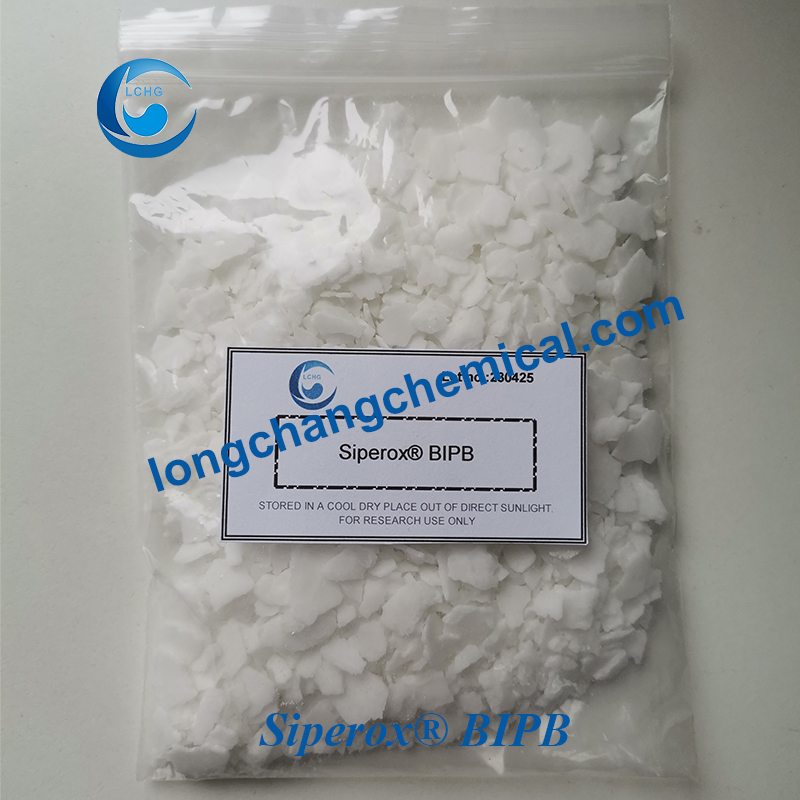Description
BIPB 96 CAS 25155-25-3
| Item | Standard | Result |
| Appearance | White powder | White powder |
| Purity,% | ≥96.0 | 97.3 |
| Melting range(℃) | 40-55 | 40-42 |
What is BIPB?
BIPB claims to have no smell of DCP, in addition to the structural similarity, there is an important reason, that is, almost where you can use DCP can be replaced by BIPB, BIPB instead of DCP adhesive performance, including hardness, breaking strength, elongation, tear strength, as well as oil resistance, aging coefficient, etc., basically the same, while the compression deformation at high temperatures, BIPB is better than DCP.
BIPB Application:
1. BIPB can be used as a crosslinking agent for rubber and plastics, such as silicone rubber, ethylene-vinyl acetate copolymer (such as EVA foam), chlorinated polyethylene rubber (CPE), ethylene propylene diene rubber (EPDM), chlorosulfonated poly Ethylene, tetrapropylene fluorine rubber (TP-2), saturated hydrogenated nitrile (HNBR). In the case of the same cross-linking effect, the addition amount is about 2/3 of other organic cross-linking agents. There is no irritating odor during operation and in the finished products. It is especially suitable for flexible cord insulation cross-linking and EVA foam products in silicone rubber molding vulcanization chambers, such as rubber sheathed cables for air conditioners, EVA foam toys, etc.
2. It can be used by adding rubber material during mixing. When the crosslinking effect is required, the addition amount of 3 parts can completely crosslink the high molecular polymer.
3. Can be used as a cross-linking agent for plastics and rubber such as chlorinated polyethylene, EPDM rubber, ethylene-vinyl acetate copolymer, silicone rubber, nitrile rubber, and fluororubber. In the case of the same cross-linking effect, the amount added is about 2/3 of the DCP, and the irritating odor in the operation process and the finished product is small.
BIPB Packaging and Shipping:
20kgs/carton
BIPB Storage:
Stored in a cool dry place(2-8° C) out of direct sunlight.
where to buy BIPB? Contact Us Now!
If you need COA, MSDS or TDS, please fill in your contact information in the form below, we will usually contact you within 24 hours. You could also email me info@longchangchemical.com during working hours ( 8:30 am to 6:00 pm UTC+8 Mon.~Sat. ) or use the website live chat to get prompt reply.
What are the reasons for BIPB and DCP being odourless and flavourful?
Thermal decomposition process of DCP:
In the structure diagram of DCP, we can see that the isopropylbenzene oxygen radical produced by the breakage of the peroxy bond during the thermal decomposition of DCP can also form methyl radicals and acetophenone, which is a substance with unpleasant odour and is harmful to the human body, which is why when DCP is used as a cross-linking agent for polymers, it has a kind of unpleasant odour during the cross-linking process as well as the finished products made of DCP. It can be seen that the reason why DCP has an odour is not because of DCP residues or impurity residues, so there is no such thing as the higher the purity of DCP, the smaller the odour.
BIPB thermal decomposition process:
Generate alkyl radicals, alkyl radicals and free polymer matrix reaction, we can see that the crosslinked small molecule products of BIPB have:
Methane (CH4) …… gas
Acetone …… volatile
Tert-butanol …… volatile
There are other remaining are some solid compounds with no smell, so BIPB has almost no smell or very small smell in the cross-linking process and in the finished products.
Advantages, disadvantages and solutions of BIPB
The reason why BIPB is called odourless DCP in addition to structural similarity, there is another important reason, that is, almost can be used in place of DCP can be replaced by BIPB, BIPB instead of DCP rubber properties, including hardness, breaking strength, elongation, tear strength and oil resistance, aging coefficient, etc., basically the same, and compression deformation at high temperatures, BIPB is better than DCP.
But BIPB has a significant disadvantage, that is, the price is too much higher than DCP, which is the biggest factor limiting the wide use of BIPB. In Europe, the use of BIPB is much higher than DCP, with the domestic producers and consumers to strengthen the awareness of environmental protection, now the domestic demand for BIPB is also more and more.
Another big disadvantage of BIPB is that, when using BIPB as crosslinking agent of EPDM, it is easy to appear the phenomenon of spraying crystal (note that it is spraying crystal, not spraying frost), and the light will go up to the bright crystal, while DCP will not. This is due to the decomposition products of BIPB and EPDM rubber compatibility and spray out. If your products are exported to foreign countries, especially in Europe, you can rest assured that customers will know that you are using a good vulcanising agent and gladly accept it. If you want to solve this crystal spraying phenomenon, there are two main methods:
3.1. Add PEG4000 into the formula;
3.2. Reduce the amount of BIPB while adding part of bis-2-5, which is equivalent to reducing the decomposition products of BIPB without affecting the cross-linking efficiency.
These two programmes have successful examples, of course, there are manufacturers of EPDM with BIPB as crosslinking agent does not appear to spray crystal phenomenon, perhaps because of one of a few additives to limit the spray of crystals, the specific why is not known.
Thermoplastic rubber TPV also use BIPB as a crosslinking agent, but with the automotive industry on the odour requirements are getting higher and higher, that is, after the use of BIPB, the odour does not necessarily meet the requirements, but also need to be further processed, such as the use of chemical/physical adsorption, de-volatilisation, drying and other processes to reduce the odour.


